Menus
- An integer character
- 4 cylinders in line, 998 cm3, 203 hp, 114.9 Nm, 206 kg all full facts, 18,099 euros.
- Discovery
- In the saddle
- Highway
- Departmental
- City
- Part-cycle
- Braking
- Comfort
- Consumption
- The test of the Ninja ZX10R in video
- Conclusion
An integer character
4 cylinders in line, 998 cm3, 203 hp, 114.9 Nm, 206 kg all full facts, 18,099 euros.
Nice surprise for me to find the Kawasaki ZX-10R, eight years after my last participation in the 24 Hours of Le Mans on a…. ZX-10R. Even though it’s not a happy memory. The green sportswoman has changed a lot since then and even more in recent months. Cylinder heads (recognizable by their red color) and distribution system have been modified for 2019, with distribution by pawls, more efficient because it involves fewer moving parts. The 2016 ZX-10R had already seen the diameter of its valves increase and its intake ducts redesigned.
 206 kg all full
206 kg all full
This KRT Replica version takes over the many successes of Kawasaki in the Superbike world championship since 2013, the first coronation of Tom Sykes. The French Sylvain Guintoli then offered the title to Aprilia, but since 2015, he has not left the Kawa box thanks to Jonathan Rea who recently signed his 5th World Champion title..
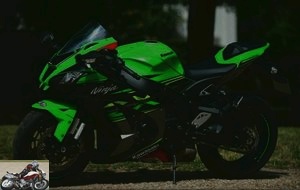 2,090 mm length, 1,440 mm wheelbase
2,090 mm length, 1,440 mm wheelbase
Discovery
The color distinguishes the KRT from the ZX-10R SE and RR, with its red highlights on the top and bottom of the fairing, as on the two official motorcycles entered in the Superbike World Championship. The four-cylinder in-line, with its new distribution, displays a potential 203 horsepower, increased by 10 horsepower dynamically with the Ram Air forced air system, according to Kawasaki (which is of no use at legal speeds ….) . Its torque of 114.9 Nm is slightly above that of the Yamaha R1, Honda CBR 1000 RR and Suzuki GSX-R 1000 but remains lower than that of a Ducati Panigale V4, its great rival in Superbike, strong from 124 Nm.
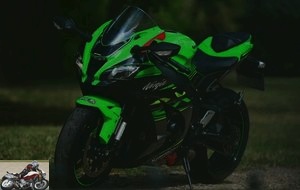 Liquid-cooled 4-stroke in-line four cylinders
Liquid-cooled 4-stroke in-line four cylinders
Like all Japanese sports cars, it has a thick aluminum frame with double spar and a swingarm of the same metal, reinforced. All the work in recent years has been to lengthen the swingarm to shorten the front end, to bring the rider closer to the steering column. A sporty 1000, it is dominated! The angle of the steering column, however, retains a value of 27 °, a priori a guarantee of stability. An Ohlins electronically controlled steering damper surmounts the upper triple clamp, which encloses the large Showa fork with adjustable rebound, compression and preload. Just like the Showa BFRC Lite shock absorber, which is lightweight, hydraulically adjustable for slow and fast speeds. Common equipment on a contemporary sports car, but all these parts are expensive and explain the price of these motorcycles, as well as their rather high weight, considering that it has changed little since the release of the Honda CBR 900 Fireblade in 1992 It was then presented with a dry weight of 185 kg. It was then measured at around 210 kg all full. The power, however, almost doubled, since the said 900 developed 124 hp, which an average roadster can easily achieve today..
 114.9 Nm at 11,200 rpm
114.9 Nm at 11,200 rpm
The other explanation for the high weight (in relative terms) comes from electronics, which have taken a considerable place on sports cars, with many sensors, an inertial unit, special frets on the brake discs, wires to connect all that etc. The ZX-10R particularly stands out in this area. In addition to its ride-by-wire throttle management (no more cable but a potentiometer to dose the power) and its Bosch six-axis inertial unit, two components essential to the various assistance systems, the Kawa of course has an ABS (said to be intelligent, which is regulated according to information sent by the sensors) and a traction control (S-KTRC) adjustable on several levels, but also a shifter up and down gears (KQS) and a maintenance aid of the trajectory (KCMF) which plays on the force applied to the brakes or the opening of the throttle to modulate the effects in order to avoid the brutal reactions of the motorcycle. Without forgetting the engine brake control (KEBC). Suffice to say that if we want to configure each of these assistances to personalize them, a few weekends will be spent there (a nod to those who enter the French championship with the ZX-10R).
 LED rear light
LED rear light
In the saddle
Once the position is assimilated, the Kawa does not bring hell to everyday life for a sportswoman. Less demanding than the Suzuki GSX-R, this position is distinguished by a certain finesse at the crotch and a fairly small space between the saddle and the straps, which avoids being too stretched out when you’re not very tall, like me. The controls are smooth, the controls are easily reached. The legs are folded up, but that’s the hallmark of any sportswoman. The dashboard is teeming with information that is not clear at first glance; you have to get used to it over time. Tiny, the screen manages to display everything, but in small print. The LED tachometer, the color of which varies according to certain speed ranges, is easy to read. As well as speed, being the most important parameters.
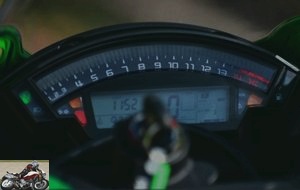 Dashboard
Dashboard
Because on this kind of motorcycle, the speed is monitored every thirty seconds or so. To respect the 80 km / h of circumstance on our secondary roads, it is enough with the ZX-10R to put on the second report at 6,000 rpm! There are then four gears to go up ….
Highway
To leave the west of Paris and reach regions suitable for tasting ZX-10R nectar, the easiest way is to go via the A13. There, you have to stall at 140 km / h meter, around 6,000 rpm and watch the time go by. With my chest resting on the tank, my arms relieved, I get up from time to time to avoid numbness. The bubble protects moderately, you really have to get inside the bike to feel its protection. As for the duo, they can only be viewed with humor. Otherwise, what to say, apart from evoking the frustration of seeing large sedans overtaking me to more than 160 (personal evaluation), confident in their Waze application or their Coyote, of which I am deprived ….
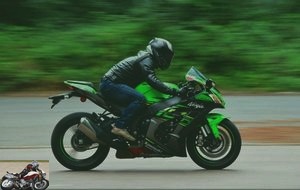 203 hp at 13,500 rpm
203 hp at 13,500 rpm
Departmental
Finally a more fun playground. The front axle quickly builds confidence. The Kawa can be taken around the bends with ease, the braking is illustrated by its progressiveness, its almost perfect feeling and its power at the end of the race. The Bridgestone RS 11 matches perfectly with the feeling of the chassis. On bumps, irregularities or heavy braking (on the road, so not with the same violence as on the track), the suspensions combine progressiveness and great absorption capacity. I stayed on the original settings for the moment, the suspension comfort was very pleasant. Obviously, the Showa elements at the front and rear are beautifully crafted.
 Bosch IMU inertial measurement unit
Bosch IMU inertial measurement unit
The engine does not have the expression of the four-cylinder GSX-R 1000, more sensational, but it is easier to operate because it is more linear and more lively in its revs. Everything here is about efficiency. This is where my comments come from when a welcoming terrace catches my eye, in a small village on the outskirts of Normandy whose name I have forgotten. Coffee, relaxation. I focus on the lines of "my" sportswoman. Each piece puts it in the spotlight, from the one-piece Brembo calipers to the thick, well-finished fairings. The painted side bothers me a little, garish. Too bad it doesn’t exist in a more subdued, solid color, but it’s a Replica. Otherwise, we will console ourselves with the black of the SE version. The finish takes it to the highest level of production motorcycles, but it is not the class of a Ducati Panigale V4.
 Lane-keep assist with functions based on KIBS and S-KTRC
Lane-keep assist with functions based on KIBS and S-KTRC
I set off again on well-paved roads, not stingy in bends. They seem to be safe from controls, passage is rare, I know it is misleading but some risks are worth it. On offense, the ZX-10R shows a more closed face. The engine remains easy to dose, despite the impressive power. The front end retains its precision but I have to force the bike to follow the desired course and once there it is not really possible to deviate it. It reacts straight out, it even lacks handling. The ZX-10R can hardly handle the road, when you brutalize it a bit. The suspensions always work in a surprisingly progressive way, taking in the braking, the acceleration, the imperfections. Rather, it’s the overall geometry that gives rise to that ‘one-piece’ side, which you don’t find on a Yamaha R1, easier but perhaps less homogeneous in its reactions. The Kawa’s inertia strain its agility, however. It takes more effort to go from one corner to the next than the Yamaha. A fairly typical reaction of Kawasaki sports cars since the first Stinger in 1989. Not to mention the ZX-7R…. It’s not an anvil, but it has yet to learn from contemporary Ducati and Yamaha. I thought it was a good idea for a while to firm up the suspensions to shorten their movements, but that doesn’t change the handling of the bike very much. Its traction is however foolproof! Without ever triggering the electronics (I think on dry roads you should go more than seriously), the rear tire always manages to propel the bike without causing movement. It then tends to widen at the end of the curve, but this is again due to its "block" aspect, whole.
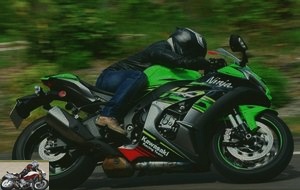 New cylinder head allowing better cam lift, formerly only on the RR version
New cylinder head allowing better cam lift, formerly only on the RR version
City
After dawdling, I take the risk of plunging into Paris. I knew very well what was going to happen, it did not fail. The position becomes difficult, luckily the heat from the engine does not reach the pilot. The first, long, often works. I sometimes pass the second, at 3,000 rpm, the four-cylinder resumes without flinching. I’ve said it before when testing sports, the only thing I like about these bikes in town is their precision (between lines, when you have to avoid an emergency etc.).
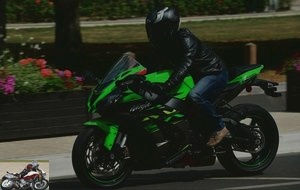 cassette gearbox
cassette gearbox
Part-cycle
The back roads revealed to me the stability of the ZX-10R but also its complexity, linked to the peculiarity of its chassis. The bike is driven in a single block, even, stable, precise, but does not support the vagueness and disturbances caused by imperfections of the road, or a brake on the corner …. Once engaged on its trajectory, the ZX-10R remains impassive. With the advantages and disadvantages of this attitude. The ZX-6R is more forgiving (and also cheaper). The suspensions and braking, on the road, are just perfect. I would perhaps advise to relax the hydraulic shock absorber by two notches, to better feel it working, especially when we weigh less than 70 kg.
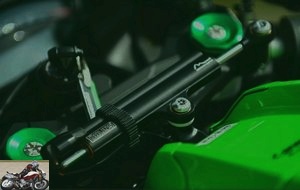 Ohlins steering damper
Ohlins steering damper
Braking
The Brembo M50 calipers, the master cylinder and the lever that controls it, all contribute to the progressiveness of the braking, very powerful at the end of the lever stroke. The ABS at the front does not interfere with heavy braking and does not react to bumpy braking. A perfection.
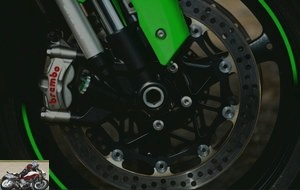 Brembo braking, double semi-floating 330 mm disc. Two radial calipers, 4 opposed pistons
Brembo braking, double semi-floating 330 mm disc. Two radial calipers, 4 opposed pistons
Comfort
This is a rather incongruous criterion for a sportswoman, but some die-hards ride these motorcycles every day and even go on weekends or on a trip on their handlebars. The driving position allows for some very pleasant movements / movements so as not to numb the muscles on the highway. The suspensions perfectly absorb shocks. Only the saddle could be a little thicker, it probably suffered the collateral damage of the weight hunt. The bubble protects quite well when you are less than 1m70 but is much less effective for adults. Also note that there is no storage space on the Kawasaki.
 Passenger seat
Passenger seat
Consumption
I drove in a very variable way during these 400 km or so with the ZX-10R, so the fuel consumption does not reveal what the fuel consumption would be in normal, everyday use. The urge to tease the big 1000 block drove me to exceed 7l per 100km, 7.2l to be exact. This is what it will cost you if you get too angry !
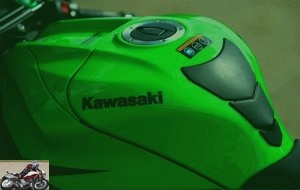 17 liter tank
17 liter tank
The test of the Ninja ZX10R in video
Conclusion
The new ZX-10R does not betray its ancestor, the first ZX-10R released in 2004, so fifteen years ago. It remains powerful, whole, but much easier than its predecessor, much more efficient too. It manages to keep the qualities of sporty Kawasaki, by reducing the defects. Faced with a Yamaha R1 or a Ducati Panigale V4, the ZX-10R will be a little rigid, sometimes reluctant, but it remains agile, powerful, with a progressive engine and a precise chassis. Its electronics work like its suspensions, with progress, without brutality, in a very efficient manner. The ZX-10R therefore retains its place on Mount Olympus.
Strong points
- Excellent quality suspensions
- Braking
- Precision
- Stability
- Powerful motor but not violent
Weak points
- Little inclined to improvisation
- Bubble a little low
- A few pounds less would be appreciated ….
Kawasaki ZX-10R KRT technical sheet
Test conditions
- Route: 440 km between the Paris region and Normandy, but above all in daily use
- Weather forecast: fine weather 25 and 38 °
- Motorcycle mileage: 3,700 km on the odometer
Test equipment
- HJC R-PHA 11 Helmet
- Jacket Furygan Dany
- Spidi Originals Gloves
Related articles
-
Kawasaki Z H2 Supercharged motorcycle test
200 hp, 14 mkg at 8,500 rpm, 239 kg all full, 17,099 € Put some salt ! Fifteen days of driving with the Kawasaki Z H2? I say it bluntly, it takes less to…
-
Kawasaki Versys 1000 motorcycle test
La Z goes green Eternal absent from the Kawasaki range, apart from the unlikely KLV 1000 (Suzuki V-Str m renamed), the maxi-trail model finally appears…
-
2012 Kawasaki ER-6n motorcycle test
New test: Kawasaki ER 6N: Sparkling with mischief ! Appeared in 2006 and restyled in 2009, the ER6 N gets a new facelift that makes it even sexier,…
-
Kawasaki Versys 1000 S Grand tourer motorcycle test
Daily test for fifteen days 1,043 cm3, 120 hp at 9,000 rpm, 102 Nm at 7,500 rpm, 257 kg, 15,099 euros (17,099 euros Grand Tourer version) This bike, to…
-
Kawasaki ZX10R motorcycle test
The motorcycle division of the giant Kawasaki industry, is only a drop in the sea, but that does not prevent it from being a major player in the world of…
-
Kawasaki Ninja ZX-10R motorcycle test
The good vein 4 cylinders in line, 998 cm3, 203 hp and 11.7 mkg at 11,400 rpm, 206 kg all full, 19,399 euros. Who has not had their adored sportswoman,…
-
Kawasaki Ninja 1000 SX motorcycle test
Compromise without compromise 4 cylinders of 1,043 cm3, 142 hp and 111 Nm, 235 kg, from 14,349 euros In 2010, Kawasaki presented its first Z1000SX, a…
-
A new little sports car accessible to A2 licenses Twin cylinder in-line, 399 cm3, 45 hp at 10,000 rpm, 38 Nm at 8,000 rpm, 168 kilos, from € 5,999…
-
4 cylinders in line, 948 cm3, 111 hp at 8,500 rpm, 10 m / kg at 6,500 rpm, 215 kilos, from € 11,999 A skillfully modified Z 900 or the worthy heir to the…
-
Size question 4 cylinders in line, 636 cm3, 130 hp, 70.8 Nm, 196 kg full made, 11,699 euros While everyone agrees to put the 600 Supersport category in…